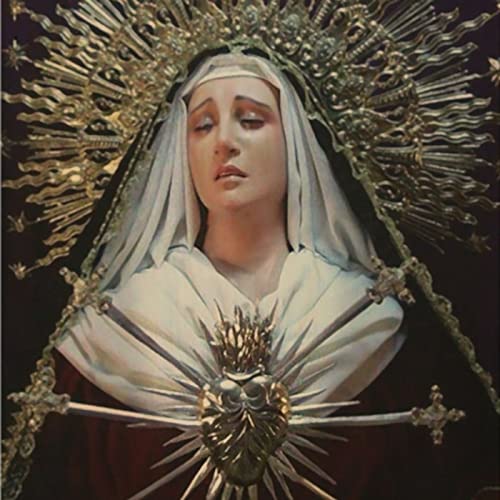September 15: Our Lady of Sorrows
Memorial; Liturgical Color: White
Patroness of Slovakia
A mother is only as happy as her saddest child
Every life climbs its Calvary. Every soul has its quiet sorrow which cannot be shared in full with any other soul. This concealed pain is the very real drama that plays out behind the curtain of the duties and distractions of everyday life. Jesus Christ, fully God and fully man, shared in all things human, save sin, including pain and sorrow. So He wept at the death of Lazarus, and He balanced the heavy cross on His sore bones and trudged up a hill to His own execution. Thoughts and ideas can be shared in their totality. Emotions and experiences only partially so. Suffering is intensely private in that it is a personal, lived experience. The intense sufferings of Jesus Christ were intensified by His perfection. It was more unjust, more cruel, that one so perfect should suffer at the hands of creatures of His own making. Only a perfect being similar to Jesus could enter into His sorrow, could experience it somewhat as He did. That person was Mary. She was not a Goddess, of course, but the New Eve, the perfect person God intended that every person should be from the start. Because she was perfect, she most understood, and felt, the pain of her perfect Son. Shared perfection led to shared sorrow.
Today’s feast commemorates the sorrows of Mary, most especially those lived during Jesus’ passion and death. Devotional images of Mary show her heart pierced by seven swords, symbolic of seven sorrows: the prophecy of Simeon; the flight into Egypt; Jesus being lost in the temple; meeting Jesus on His way to Calvary; standing at the foot of the Cross; being present when Jesus was removed from the Cross; and her presence at His burial. Mary was perfect, but her life wasn’t perfect. She was squeezed by the same wine press of pain, humiliation, and sorrow that squeezes every life. She was unmarried and pregnant and must have heard the neighbors’ whispers as she walked the dusty streets of her town. She and her family had to flee to a far-off land to escape the murderous King Herod the Great. She lived a real life stuffed with real human drama. But her most intense sorrows were felt when she was in her late forties, when her one and only child died a public death, leaving her, already a widow, totally alone, her middle-aged face stretched with sorrow.
When our fingers and thumb walk up and down the chain of God’s mercy, we ruminate over things glorious, joyful, luminous, and sorrowful. We recall historical events like Christ’s Baptism and the Last Supper, and theological events like the Assumption and the Coronation.
The Sorrowful Mysteries are historical. Mary hovers just off center stage. She stands nearby, amidst the crowd on the path to Calvary, upright and brave at the foot of the Cross, weeping as her dead boy is wrapped in a sheet and delicately placed on a cold slab in a rock-cut tomb. She is Our Lady of Sorrows because she, and the Church, are mothers. They give and nurture life. They feel more than men. They respond to suffering with co-suffering, not so much through actions and solutions. On today’s feast, we recall Mary’s sorrow and share in it. But our sorrow is not that of a godless Viking, a pagan Roman, or a modern secularist. Christian grief is not godless grief. Our grief, like Mary’s grief, is ameliorated by the sure and certain hope that the last word in our book is not death and despair but hope and life. Mary’s sorrow is temporary, as all of our sorrows one day will be. There is nothing that does not have a context, except for God. And the context for Christian sorrow is the Resurrection.
Mary of Sorrows, you shared the pain and sorrow of your perfect Son but were never forlorn. Help all who turn to you to unite our sorrows to yours and His so that we may co-suffer in His death and co-share in His Resurrection.



